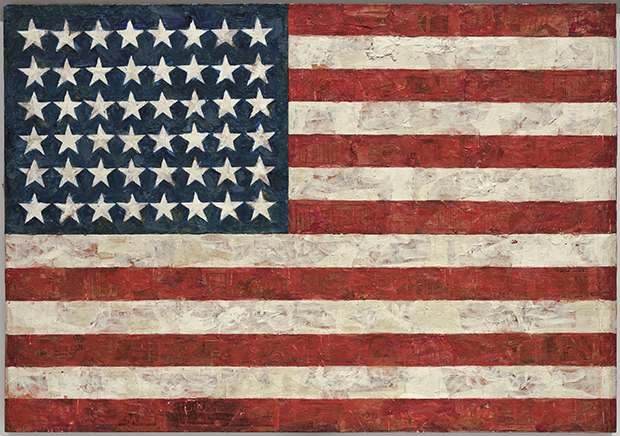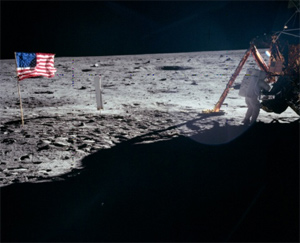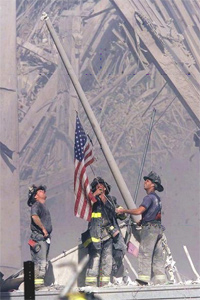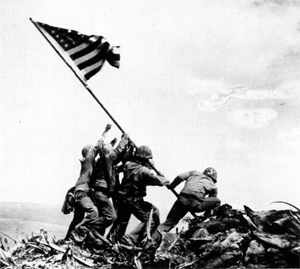June 14th is the day in 1777 when the Continental Congress commissioned the official flag of the United States of America. While folklore credits the design of the official flag to Betsy Ross, an upholstery store owner and seamstress in Philadelphia, scholars think the designer was actually Francis Hopkinson. This is one of the few instances when a woman is remembered historically while the man involved has become invisible. The origin of the flag's design is murky since the Congress refused to pay Hopkinson for the design saying others had contributed. Most likely the Congressional stance of withholding payment for the design was mostly about saving money since Hopkinson is credited with designing the first paper money for the Continental Congress, the United States Seal, and the first United States coin. He also designed the Navy flag.
Judge Francis Hopkinson (1737 - 1791) was an 18th century Renaissance man. He was one of the Pennsylvania signers of the Declaration of Independence. He wrote articles and stories supporting both the American Revolution and the new Constitution. He also played the harpsichord and the organ, wrote music, and even created a new musical instrument. He was appointed a District Court Judge by George Washington and corresponded with Washington, Jefferson and Franklin until his early death at age 53 from an massive epileptic seizure.
Flag Day didn't become official until 1916 when President Woodrow Wilson issued an official proclamation designating June 14th as Flag Day. This date was already being celebrated unofficially all over the United States. It wasn't until 1949 that President Harry Truman signed into law the legislation for Flag Day passed by both houses of the United States Congress. The legislation was amended in 1966 to designate the week which included the date June 14th to be Flag Week. Whew! It's pretty hard to become an official holiday, but Flag Day which morphed into Flag Week, however, is NOT an official Federal holiday.
As with all legislation, there are several interesting aspects. First, the President is required by law to deliver a flag day proclamation every year. The actual design of 13 red and white alternating stripes with 13 stars on a blue field representing a new constellation comes from the original 1777 Continental Congress. There have been 27 versions of the American flag as territories became ratified as states. It wasn't until 1912 that President Taft formalized the layout of the 48 stars. The 48 star flag design lasted from Arizona (state ratification 1912) until 1959 (Alaska). There was a new flag design for one year until July 4, 1960 when Hawaii became a state. The 1960 star arrangement is still in effect today since Hawaii is the last US territory ratified as a state.
We've seen the flag represented in a myriad of configurations. We each have our favorite representation. Here are some of mine:
Here's the flag flying when Francis Scott Key wrote the Star Spangled Banner (This one has been loved to death and actually defaced with one of the fifteen stars cut out and 'trimmed' by souvenir seekers down from 42 feet long to 34 feet.) It's very fragile, and it moved me when we saw the actual flag in a special Smithsonian exhibition a few years ago.

The WPA sponsored artists during the Great Depression and I like this commissioned centennial poster celebrating Flag Day in
DuPage County, Illinois.

The iconic photograph raising of the American flag on Iwo Jima in 1945 is an enduring flag image. The photo won a Pulitzer Prize in 1945. Three of the men raising the flag were subsequently killed during the war, and the remaining three became famous as a result of this picture.
Artist Jasper John's iconic flag art piece came to him in a dream in 1955. It's an encaustic (hot wax technique) piece is supplemented with oil paint, and newsprint, with three layers making it a collage. It's 42" by 60" and is in the Museum of Modern Art in New York City. (I've seen it, and it's very striking.)

An American flag only a handful of people have actually seen in person is represented by this photo. That's the flag Neil Armstrong planted on the Moon.

Following the terrorist attack on the United States, the raising of the American flag over the World Trade Center rubble echoed the Iwo Jima flag.

You can find the image of the American flag in every configuration. It's on t-shirts, the seat of your pants, on key chains, bikinis, coffee cups, and gimme caps to name a few. It's been imprinted on everything you can imagine and represented in every way imaginable like with people in this photograph.

This cap is in the LBJ museum in Austin, Texas.
And this photograph is just an amazing representation of the flag.

We take the symbol of the American flag seriously and lightheartedly. Today, though, is a good day to remember the purpose of our flag is to symbolize the unity of Americans under these words:
"We the people of the United States, in order to form a more perfect union, establish justice, insure domestic tranquility, provide for the common defense, promote the general welfare, and secure the blessings of liberty to ourselves and our posterity, do ordain and establish this Constitution for the United States of America."

1 comment:
I still fly a 48 star flag almost ever day.....It is the one I was born under.
Post a Comment